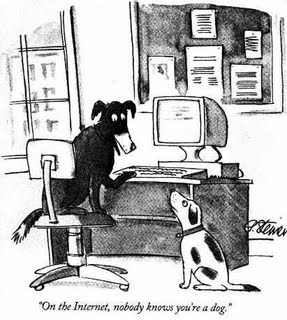
[This post was edited 7/30/10 as some links went dead]
In 1993 The New Yorker published this now-classic cartoon with the caption, “On the Internet, nobody knows you’re a dog.” Initially created for a little chuckle, it’s turned into a prophetic warning. Anyone could be lurking on the other side of that keyboard.
One example played out on the websites of two law bloggers who were being cyber-stalked. The stalker happened to be a convicted rapist, and Twitter was his tool.
And this is worth writing about as a lesson to newcomers to the blogosphere and those who think acquiring a jillion Twitter followers, or a bazillion Facebook friends, will magically lead your nascent law firm down the Yellow Brick Road to Oz. It doesn’t work that way. And it could even be dangerous.
You would be foolish not heed the dangers of the web. Don’t be so quick to add Twitter and Facebook buddies under the pretension that these networks give you a level of familiarity with others if that familiarity doesn’t actually exist. If you don’t know how to say no then you aren’t an adult.
Just as social networks are used by the innocent, so too are they used by trolls, malcontents and criminals. You don’t want to learn the hard way about the difference between a follower and a stalker. This is particularly true since, as Kevin O’Keefe points out, there is software that will help buy Twitter followers. He issues his own mea cupla on once touting the benefits of large numbers of followers.
I’ve never been a fan of Twitter and the blizzard of garbage it sends over the transom at the user. If you use the service (or any other) quality must take precedence over quantity.
As Sergeant Phil Esterhaus used to say on Hill Street Blues, “Hey, let’s be careful out there.”